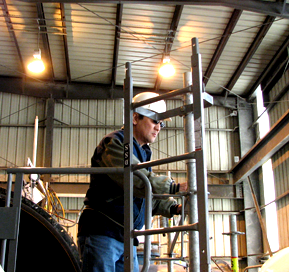Wadham Energy LP

The Sacramento valley, which produces about 20 percent of the U.S. rice crop, dominates California rice production. Until 1990, California rice crops also yielded rice waste disposal problems that affected the region’s air and soil. Today a modern, efficient renewable energy plant is turning this potential environmental problem into an energy solution. In the heart of Colusa County, a major rice producing county within the Sacramento valley, the Wadham Energy biomass facility, the world’s largest rice hull-to-energy plant, is utilizing rice waste to generate greenhouse gas friendly sustainable electric energy.
Supporting A Sustainable Environment
Before Wadham began operations, disposing of rice chaff, or hulls, which are removed from rice before it can be used, had become an increasingly troublesome problem for California rice mills. Over 400,000 tons of hulls, are produced each year, far more than could be used in beneficial applications. The unused balance had to be disposed. The slow-to-break-down rice hulls produced methane, a greenhouse gas (GHG), and unintended open-field burning produced unacceptable levels of pollution. Wadham solved the dilemma of rice hull disposal by transforming the hulls into fuel and generating enough electricity to power approximately 22,000 area homes without polluting the soil or air. Outside the City of Williams, 55 miles north of Sacramento, the Wadham biomass facility can convert approximately 200,000 tons of rice hulls per year into 26.5 MW of electricity. This power is sold under contract into the California renewable energy market. This electric process is GHG negative in that the fuel was created by plant life absorbing CO2 and its combustion releases the same amount, however, if left to decompose, the rice hulls would produce methane, a gas that is 21 times more harmful than CO2 as a GHG.

An Efficient, State-Of-The-Art Operation
Designed with leading-edge technology, Wadham cleanly incinerates nearly 29 tons of rice hulls per hour, between 600-700 tons per day. Delivered from huge storage silos, the rice hulls are fed from a metering bin to grinders where they are pulverized and pneumatically conveyed to a steam generator. The steam generator includes two large superheaters, two reheaters, an economizer, and three air heaters. Eight burners fire the pulverized rice hulls in suspension at a temperature of 1575ºF. The heat generated from the combustion of the rice hulls converts water into high-pressure superheated steam. Piped to two high-efficiency steam turbines, the steam drives a 30 MW generator that produces electricity.
Technology That Protects And Conserves
Wadham’s waste recycling process eliminates open-field dumping and subsequent burning or methane generating decomposition thereby reducing harmful emissions and helping to lessen the haze in the Central Valley. The facility meets California’s strict pollution control laws by controlling the emissions from its operations with fabric filters and dust collectors for its flue-gas, ash and fuel-processing systems. In addition, Wadham is a zero-wastewater-discharge facility that uses two hydraulically segregated cooling loops to minimize water consumption.
Recycling a Valuable By-Product
Rice hull silica (RHS), Wadham’s primary by-product, is a sand-like material. A biogenetic, amorphous silica product, it is a valuable and versatile commodity for a number of industries. Wadham can sell its RHS to the steel industry as an insulating material for molten ladles of steel. The RHS can also be used as a feedstock to chemical processes to produce sodium or potassium silicate, precipitated silica or photovoltaic quality silicon. Wadham silica is also used in agriculture as a soil amendment to help break up heavy clay soils.
A Harvest Made More Bountiful
As they have for nearly a century, farmers in California’s Sacramento valley continue to grow rice in a soil and climate ideal for cultivating the grain, but with a difference. Now, as their crops and markets multiply, the by-products of their harvests are no longer harmful wastes. Rice hulls are a resource that fuel a clean, efficient, global climate friendly energy process which produces economical renewable electrical power. They also serve as important ingredients in the manufacture of industrial products. Through recycling, the Wadham biomass facility is creating important new resources while helping to sustain the vitality and beauty of California’s land and air.
Owner
Wadham Energy Limited Partnership
c/o Enpower Management Corp.
2410 Camino Ramon, Suite 360
San Ramon, California 94583
(925) 244-1100
Wadham Statistics
Rice Hull Use
Rice Hulls Consumed: About 200,000 tons per year
Electric Generation
Maximum Plant Capacity: 26.5 MW
Electricity Generated: About 200,000 MWh per year
Commercial Operation: Second quarter, 1990



